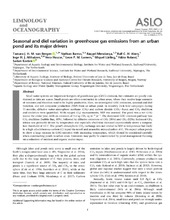| dc.contributor.author | van Bergen, Tamara J.H.M. | |
| dc.contributor.author | Barros, Nathan | |
| dc.contributor.author | Mendonça, Raquel | |
| dc.contributor.author | Aben, Ralf C.H. | |
| dc.contributor.author | Althuizen, Inge | |
| dc.contributor.author | Huszar, Vera | |
| dc.contributor.author | Lamers, Leon P.M. | |
| dc.contributor.author | Lürling, Miquel | |
| dc.contributor.author | Roland, Fábio | |
| dc.contributor.author | Kosten, Sarian | |
| dc.date.accessioned | 2020-05-03T16:12:49Z | |
| dc.date.available | 2020-05-03T16:12:49Z | |
| dc.date.issued | 2019-09 | |
| dc.Published | van Bergen, Barros N, Mendonça, Aben, Althuizen I.H.J., Huszar, Lamers, Lürling M, Roland, Kosten S. Seasonal and diel variation in greenhouse gas emissions from an urbanpond and its major drivers. Limnology and Oceanography. 2019;64(5) | eng |
| dc.identifier.issn | 0024-3590 | en_US |
| dc.identifier.issn | 1939-5590 | en_US |
| dc.identifier.uri | http://hdl.handle.net/1956/22069 | |
| dc.description.abstract | Small water systems are important hotspots of greenhouse gas (GHG) emission, but estimates are poorly constrained as data are scarce. Small ponds are often constructed in urban areas, where they receive large amounts of nutrients and therefore tend to be highly productive. Here, we investigated GHG emissions, seasonal and diel variation, and net ecosystem production (NEP) from an urban pond. In monthly 24‐h field campaigns during 11 months, diffusive water–atmosphere methane (CH4) and carbon dioxide (CO2) fluxes and CH4 ebullition and oxidation were quantified. With oxygen (O2) measurements, NEP was assessed. The pond was a net GHG source the entire year, with an emission of 3.4 kg CO2 eq m−2 yr−1. The dominant GHG emission pathway was CH4 ebullition (bubble flux, 50%), followed by diffusive emissions of CO2 (38%) and CH4 (12%). Sediment CH4 release was primarily driven by temperature and especially ebullition increased exponentially above a temperature threshold of 15°C. The pond's atmospheric CO2 exchange was not related to NEP or temperature but likely to a high allochthonous carbon (C) input via runoff and anaerobic mineralization of C. We expect urban ponds to show a large increase in GHG emission with increasing temperature, which should be considered carefully when constructing ponds in urban areas. Emissions may partly be counteracted by pond management focusing on a reduction of nutrient and organic matter input. | en_US |
| dc.language.iso | eng | eng |
| dc.publisher | Wiley Periodicals, Inc | en_US |
| dc.rights | Attribution CC BY | eng |
| dc.rights.uri | http://creativecommons.org/licenses/by/4.0/ | eng |
| dc.title | Seasonal and diel variation in greenhouse gas emissions from an urbanpond and its major drivers | en_US |
| dc.type | Peer reviewed | |
| dc.type | Journal article | |
| dc.date.updated | 2019-11-15T08:27:42Z | |
| dc.description.version | publishedVersion | en_US |
| dc.rights.holder | Copyright 2019 The Authors | en_US |
| dc.identifier.doi | https://doi.org/10.1002/lno.11173 | |
| dc.identifier.cristin | 1693602 | |
| dc.source.journal | Limnology and Oceanography | |

